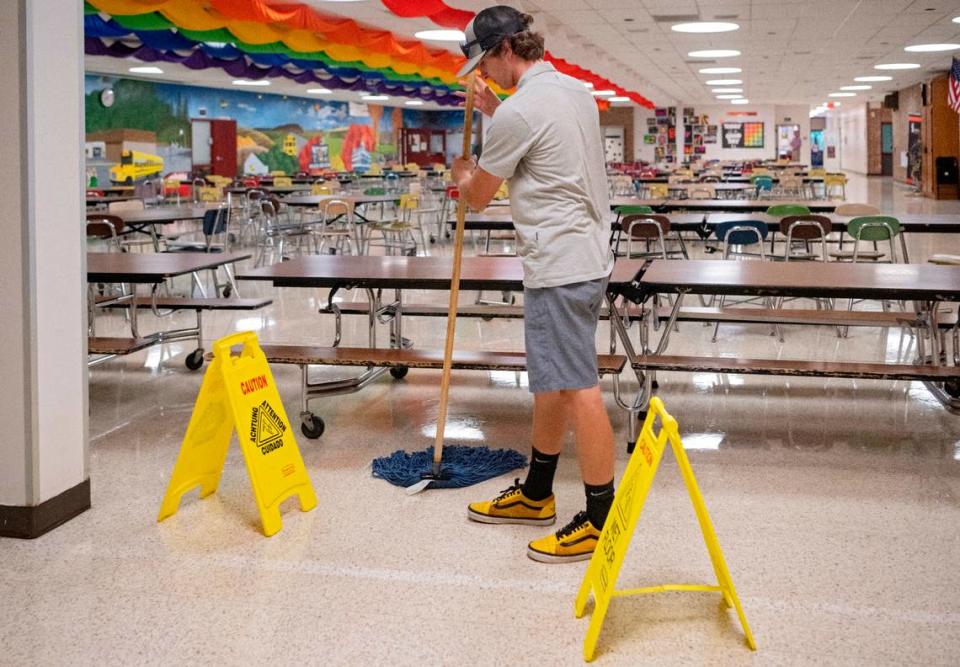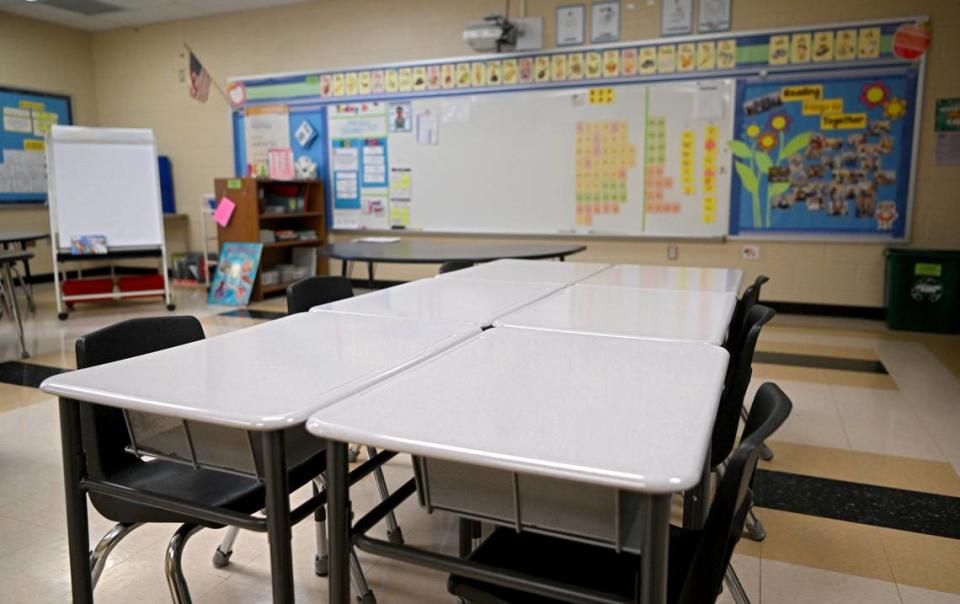New school year, same staffing shortages in Centre County schools. What’s the solution?
Curtis Whitesel has served as the Bald Eagle Area School District superintendent for nine months, and during that time he has received zero applications for open custodial positions. Despite the three positions available and the district’s continual hiring search, he’s had no luck.
There’s just no one applying for the job that starts around $12 an hour, with applications slim for other positions that support operations across the rural Centre County school district.
As a new school year begins, Bald Eagle Area is not alone. While teacher shortages remain an issue, districts across the nation are grappling with shortages for all positions, with support staff vacancies causing serious problems. In mid-August, a Kentucky school district halted classes after a new bus system, which aimed to alleviate the district’s lack of bus drivers, caused mass chaos.
The problem is compounding — lack of support staff can put added pressure on teachers and administrators, and ultimately harm students, Kris Vancas, director of curriculum for Bellefonte Area School district, said.
“Having these staff shortages can disrupt the educational process for students and they can hurt student growth and achievement over the long run,” Vancas said. “Sometimes without enough teachers or without enough support staff, students won’t always receive the rigorous instruction that we want them to have.”

New challenges for hiring support staff
As positions like cafeteria workers, custodians, maintenance workers and paraprofessionals have gone empty, administrators have tried to fill the need. Bus drivers and crossing guards, which are not district employees, have also seen shortages, with efforts initiated to help fill voids. In August, PennDOT removed a requirement for bus drivers in an attempt to make the hiring process easier.
In the months leading up to the start of the school year, districts have advertised their open positions on various job sites, social media and mailers to homes. They’ve also raised pay in the hopes of attracting more applicants. This summer, the State College Area School District board approved new contracts with the teachers union and the educational support personnel association to include more competitive wages.
Under the district’s new contract with the State College Educational Support Personnel Association, the hourly rate for paraprofessionals starts at $14.38 for the 2023-2024 school year. Rates rise with years of experience and increase a percentage each year. By the 2027 school year, paraprofessionals will start at $18.03.
Still, more than 14 support staff positions remained unfilled at the start of the year. Patricia Storch, president of the SCESPA, said she believes the district will be able to fill the positions with the competitive wages in the contract.
“However, we continue to be vigilant,” she wrote in a statement. “To attract and retain qualified people and fully support district offices and classrooms, we must promote the importance of our members and advocate for the best possible terms for them during future contract negotiations.”
State College Area School District Superintendent Curtis Johnson said the districts aren’t just competing with each other for staff, but also local businesses. People who would have once become custodians or maintenance workers at a school district are now finding similar benefits and more competitive pay in the private sector.
“At one point we were able to get people just because we offer a retirement package and benefits, a good salary,” Johnson said. “But now even fast-food restaurants are offering retirement, good benefits and a good salary.”
Paraprofessionals, often known as teachers’ aids, can be especially hard to find in an ever-changing job market. Paraprofessionals are hourly employees, only earning money for the 180 to 185 days of the school year and unable to apply for unemployment in the summers.
The shortage isn’t only down to pay but the increased need for paraprofessionals in schools. Paraprofessionals can commonly be found in special education classrooms, where some students’ individualized education plans legally require a paraprofessional. But post-COVID, more teachers are using paras to help with the uptick in student needs, Elaine Selfridge, director of special education for Philipsburg-Osceola School District, said.
“When the schools were shut down, it was really hard on our students. And coming back from that we’ve seen an increase in need,” she said.
For the first time in three years, every paraprofessional position is filled at Philipsburg Osceola, Selfridge said. However, the district has no paraprofessional substitutes, often relying on building subs or shuffling staff to cover. The lack of subs is so evident that it’s become a new daily routine for administrators.
“My day starts anywhere between 5:30 and 6:30, with a group text that we have among the administrators and it’s basically like, ‘Here are the open positions that we have for the day, how are we going to cover it?’”

Teacher shortages persist
New teaching certifications have been steadily dropping in the past years, with in-state certifications reaching a record low. But as fewer and fewer new teachers are certified, the number of emergency certifications continues to grow.
As a longtime educator, Whitesel recalled a time when each new teaching position garnered dozens of applicants. Now, he said he’s lucky to get a handful for each position. Teaching positions for higher level math, foreign language and career and technical education are even harder to fill.
“Right now we’re hoping and scratching and clawing and hoping that we get three math applicants, four English applicants, 10 elementary applicants,” Whitesel said.
When districts are unable to find a qualified candidate, they are able to petition the state to emergency certify someone with a bachelor’s degree. Emergency certified teachers are allowed to teach immediately, as long as they are enrolled in classes to obtain their teaching certification.
A 2022 report from Ed Fuller, a professor of education policy at Penn State, found that in 2011-2012, 896 positions were filled by emergency certified teachers. By 2020-2021, that number rose to 5,958, surpassing the number of new certifications issued.
But emergency certifications were meant to be used as a stop gap, not a permanent solution for the educator shortage. Although districts have had success in emergency certified teachers, relying on employees who are still undergoing training provides its own set of problems. Some studies have shown that students taught by fully certified teachers achieve at higher levels when compared to uncertified teachers.
“Obviously, that’s going to affect the quality of education (the students are) going to receive and that could kind of compound in the future as far as some of those negative effects,” Vancas said.
Even as districts work with collective bargaining units to make pay more competitive, the cost of an education degree can outweigh the eventual salary, Whitesel said.
“The price of higher education right now is just through the roof and as long as we continue to require a four year bachelor’s degree as credentials for teachers ... instead of having a $40,000-$50,000 college payment, they’ll have a $90,000 college payment with hopes of making $40,000-$50,000 a year,” Whitesel said.
With fewer teachers getting certified, educators are also anticipating problems down the road when it comes to finding administrators. With the increasing demands of the job, it’s more common for teachers to burn out early or decide they aren’t interested in pursuing the administrator track, Whitesel said.
“Our lack of leadership and lack of administrators across the commonwealth is going to be just as big as the lack of teachers over the next several years,” he said.
What do schools need?
Educators across the country are looking for ways to alleviate staffing shortages and bring more teachers and support staff into schools, but many of the solutions require changes at the state level. Educators in Centre County pointed to two ways the state could remove barriers to the process of becoming an educator: funding and certifications.
“The first thing is the state needs to provide districts more money so we can increase starting salaries and then we need to find a way to get these people educated at a lower rate,” Whitesel said.
Increased funding would help schools raise pay rates to compete with private businesses, especially for positions like maintenance and custodial work. Removing barriers to certification, like lessening the requirements, could help increase the number of certified teachers.
In the meantime, districts are working on attracting and retaining staff at all positions, including providing support for the teachers and support staff working to cover losses.
“It’s a difficult situation for everybody and I think all school districts are in the same boat,” Vancas said. “But fortunately, we have a lot of good people who could kind of pick up the pieces when we are a little bit short staffed and we figure out a way to get jobs done that need to be done.”

